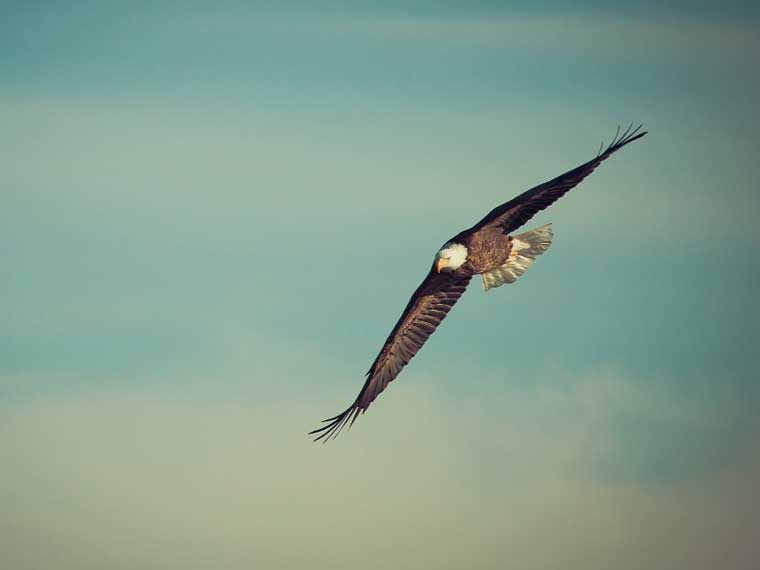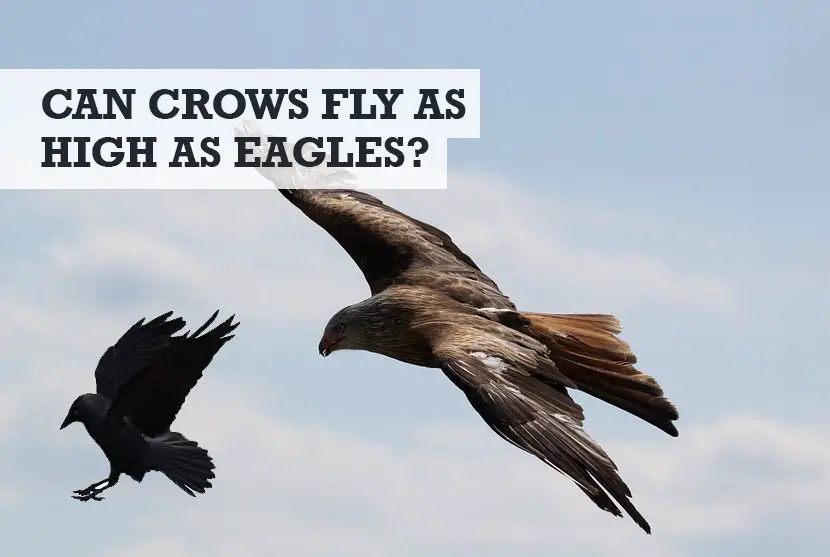When you watch crows and eagles flying in the sky, you’ll automatically assume they are at the same height level from the ground. What if I told you that one flies a lot higher than the other? But which is it… here’s the answer to whether an eagle can fly higher than a crow?
Can crows fly as high as eagles? No, crows cannot fly as high as eagles. Eagles are known to fly as high 10,000 to 20,000 feet, but crows fly much lower on average at 1,000 feet. So, in conclusion, crows can’t fly as high as eagles.
Can an eagle fly higher than a crow?
An eagle takes the trophy when it comes flying incredibly high. As studies show, eagles can fly to heights between 10,000 to 20,000 feet from the ground – higher than a storm!
On average, crows can’t fly past 1000 feet. A crow will only go slightly higher than 1000 feet on rare occasions, such as during migration.
Read on to discover the amazing advantages that make an eagle fly over ten times higher than a crow. Why can’t a crow reach such great heights? You’re about to find out.

The eagle vs. the crow: who flies higher?
Ever heard motivational speakers make this statement: “Fly as high as an eagle no matter what the altitude is?” A statement used to encourage people to stretch beyond their comfort zone.
An eagle can go all the way up, literally. As stated earlier, an eagle will fly as high as 10,000 to 20,000 feet from the ground. That’s a high altitude for a bird.
But the same can’t be said about a crow. A crow rarely goes higher than 1,000 feet. If a crow tries to fly as high as an eagle, be sure it will get too dizzy and even collapse!
I’m tempted to think that eagles have it all. Not only are they strikingly beautiful birds, but they also do great in the flying category.
Several factors influence a bird’s ability to fly to higher altitudes:
- The bird’s wingspan
- The bird’s body shape
- The bird’s biological structure
- The bird’s predatory tendencies or feeding habits
As you’ll soon see, all these factors favor an eagle’s ability to fly higher than a crow.
Eagle vs. Crow: wingspan
It’s easy to think that flying is such a simple practice for birds.
I mean, we watch them do it effortlessly. Truth is, flying takes a lot of energy, even for birds. But a bird’s wingspan makes the flying process less tedious.

A full-grown eagle has an average wingspan of between 2 to 2.5 meters long (or 6.6 to 8 feet long).
A crow, on average, has a 1-meter-long wingspan.
The eagle’s long wingspan enables it to produce lift when flying.
What’s lift? You may ask.
Lift is the vertical force that pushes a bird upwards during flight. Lift also makes a bird’s body weight feel bearable during take-off. An eagle is a heavy bird. But thanks to its wingspan, flying doesn’t feel exhausting.
That said, when flying, an eagle flattens the position of its long wings. This position pushes air downwards, creating resistance (an upward force).
Also, when flying up, air quickly moves above a bird’s wing surface. This air movement reduces the air pressure on a bird’s wing surface, making it possible for a bird to generate greater lift.
A longer wingspan like that of an eagle means there’ll be a longer path of air on the eagle’s wing’s surface.
Because of its wide wings, an eagle will have little air pressure on its wing’s surface. The lift will be greater, and the eagle can go higher. The upward force generated allows an eagle to continue soaring.
You’ll see eagles soaring even when their wings aren’t in motion. That’s because the upward force created pushes the eagle upwards without it having to flap its wings.
A crow’s wingspan is smaller. Meaning, a crow can’t produce enough lift.
A crow will need to fly faster to create as much lift as that produced by an eagle’s wings. Flying fast makes a crow use up a lot of energy to fly. It will get tired quickly, making it impossible to reach high heights.
Without wings as wide as that of an eagle, a crow can’t stay in the air for long in the presence of low-density air (found in high altitudes). Watch how this crow lands on an eagle’s back for what looks like a “free ride”.
Eagle vs. Crow: body shape
In birds, a streamlined body shape is one where the body is quite wide at the center but narrows down towards the tail.
See how a fish’s body shape appears? Now that’s what we call a streamlined body.
An eagle’s body is more streamlined compared to a crow’s body. A streamlined body enables the eagle to experience little to no air resistance when moving upwards.
A crow will not achieve the same ease of movement as that enjoyed by an eagle when flying up. For this reason, an eagle will fly higher than a crow.
Eagle vs. Crow: biological advantages
Not all birds can withstand high altitudes.
For a bird like an eagle flying heights of over 10,000 feet, it only means that they‘re biologically equipped to endure the health struggles triggered by high altitudes.
In high-altitude environments, there’s a high risk of birds collapsing due to low oxygen levels and exhaustion.
So, how do eagles do it?
Unlike crows, eagles have special features which allow them to fly to risky heights.
1. A large, efficient lung structure
Eagles have wide lungs that allow them to breathe well even when flying high. Crows don’t have such a lung structure.
2. Special mitochondria
To fly to greater heights, birds need a lot of energy to sustain their flights. Eagles have unique mitochondria that crows lack.
These special mitochondria enable high metabolism in eagles. Increased metabolism means an increase in energy production. An eagle will fly higher without feeling exhausted because there’s enough energy to sustain its flight, unlike a crow.
3. High hemoglobin levels
At high altitudes, it’s a matter of life and death because of the little oxygen available in these environments.
Eagles are lucky to have high hemoglobin levels in their blood. With high hemoglobin (which is often rich in oxygen), an eagle will have enough amounts of oxygen circulating in its body when flying high.
A crow isn’t fortunate to have such high hemoglobin levels. So, when flying, they depend on the oxygen in the air. A crow can’t fly too high because it will experience oxygen shortage.
There’ll be no adequate oxygen flowing to the crow’s vital body issues. Unlike an eagle, a crow will pass out
4. Feathers
Eagles also have thousands of strong feathers which help them conserve heat when flying high altitudes. Unlike a crow, an eagle can’t freeze when it’s high in the sky.
Eagle vs. Crow: predatory tendencies and feeding habits
Sometimes, flying high is a matter of choice for these two birds.
A crow will see no point in flying too high in the sky just to catch prey. Crows eat almost anything under the sun. Food is available to them on the ground – on the other hand, here’s what eagles eat in the winter.
An eagle has to strategize when attacking its prey. And what’s its sure way of winning a meal? Eyeing and grabbing prey from the highest point.
Crows are also cautious of flying too high. Why? To avoid encounters with aggressive birds of prey that attack them in the air.
Related questions
How high can the eagle fly?
As stated earlier, eagles can fly as high as 10,000 to 20,000 feet (3,000 to 6,000 meters) on average above the sea level. How high the eagle flies will also depend on their age, species type, and weather conditions.
You can read more about the height limits of eagles flying, in this post.
Will an eagle fight a crow?
Yes. An eagle will fight a crow in defense — for example, if a crow tries to harass the eagle then the eagle will fight back, and probably overcome the crow in a fight.
Can eagles fly further than other birds?
No. Sure, an eagle does fly high. But it cannot beat birds like vultures, cranes, mallard ducks, bar-headed geese, which go higher than 20,000 feet.
Did You Know? Geese can fly up to 200 miles on a journey without having to stop!
Does a crow fly on an eagle’s back?
There’s a common misconception that crows ride on eagles. This all stems from a series of photographs showing a crow land on top of an eagle for a ride mid-flight taken by photographer Phoo Chan.
The National Geographic website said at the time:
According to a biologist who specializes in crow behavior, the bird was likely in the middle of a territorial attack when it landed briefly on the eagle’s back, National Geographic reports. Even the presence of a larger bird provokes a defensive reaction. In this case, the crow got closer than smaller birds typically do and settled in for the ride.
So, does a crow fly on an eagle’s back? Well, the answer is that it’s rare to see a crow flying on an eagle’s back. Crows and eagles don’t get along. Only a daring crow will fly on an eagle’s back.
Can an eagle fly higher than a plane?
Eagles will often fly higher than small private planes. However, they cannot fly higher than a commercial aeroplane, which might reach heights of 42,000 feet – almost twice as high as an eagle (or crow) could ever fly.
What flies higher than an eagle?
Aside from commercial planes flying higher than eagles, there are two birds in particular which break records when it comes to flying high. Ruppell’s griffon vulture is said to reach heights of 37,000 feet
Then you have a bar-headed goose, which has been seen flying over the Himalayan mountain range at heights of nearly 28,000 feet. Much higher than an eagle (and definitely a crow)!
Conclusion
There really is no contest when it comes eagles flying higher than crows. Eagles win every time!
You might also like…
- The consequences of killing a bald eagle are severe
- How much unscrupulous traders sell bald eagles for
- How your cat should be careful near eagles
Image in header via https://pixabay.com/photos/eagle-bird-flying-flight-217591/


